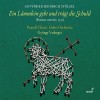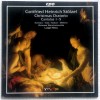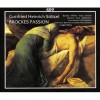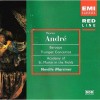Composers
Gottfried Heinrich Stölzel (13 January 1690 in Grünstädtel – 27 November 1749 in Gotha) was a prolific German composer.
Stölzel grew up in Schwarzenberg, Saxony in the Erzgebirge. From 1707 he was a student of theology in Leipzig, and of Melchior Hofmann, the musical director of the Neukirche. He studied, worked and composed in Breslau and Halle. Then an eighteen-month sojourn in Italy from 1713 — where he met Antonio Vivaldi in Venice — rendered him au courant with the latest musical taste. After working for three years in Prague, he became briefly court Kapellmeister in Bayreuth and Gera. Then in 1719 he married, and the next year took up an appointment in Gotha, where he worked until his death for the dukes Frederick II and Frederick III of Saxe-Gotha-Altenburg, composing a cantata each week.
From 1730 the Kapellmeister of the court at Gotha also wrote for Sondershausen. Stölzel supplied numerous festive occasional pieces and arias for court performance; the archive at Schloss Sondershausen retains many of his manuscripts, found in a box behind the organ in 1870. Half of Stölzel's output, never engraved, is lost. Stölzel's immediate successor at the court in Gotha, Georg Benda, bears some responsibility in both saving and losing many of Stölzel's works. In 1778 Benda wrote: "... Only the best works of my predecessor, which could be used even today for church music, are saved, because already a long time ago I separated them from useless junk and kept them in my own house." [1] This suggests that occasional music (birthday cantatas, serenatas), operas and so on, and most of Stölzel's instrumental music were lost during Benda's lifetime. Those "junk" pieces were apparently taken to the castle attic where holes in the roof exposed the manuscripts to rain and mildew damage, and rodents also ate the paper manuscripts as well. Another reason why so much music vanished is based on research by Christian Ahrens (2009)[2] According to Ahrens, musicians at the court apparently took instruments and music manuscripts and sold them in advertisements in local Gotha newspapers. Stölzel apparently did this himself before his death, and with Benda's prejudiced view towards the instrumental pieces, it is theorized that the musicians felt this gave them tacit permission to resell the music. The losses were staggering: Stölzel is reputed to have composed over 18 orchestral suites alone, (not a single one survives) as well as 90 serenatas (vocal pieces performed as "table music"). In fact, out of what had to have been thousands of compositions in Gotha, only twelve pieces survive.
He enjoyed an outstanding reputation in his lifetime: Lorenz Christoph Mizler rated him as great as Johann Sebastian Bach. Johann Mattheson reckoned him among "the level-headed, learned, and great music masters" of his century. Stölzel was an accomplished German stylist who himself wrote a good many of the poetic texts for his vocal works. Students beginning the piano may remember some pieces by him, those that are included in the Notebook for Anna Magdalena Bach.[citation needed]
His most important works are: four concerti grossi, many sinfonias, and a concerto for oboe d'amore. His four operas: Narcissus, Valeria, Artemisia, and Orion have not survived. Musicologists and conductors such as Ludger Rémy have successfully revived his music. Oratorios such as a version of the Brockes Passion (1725) and two Christmas Oratorios, made of cantatas,[3] have been recorded, also a Deutsche Messe (German Mass), a Lutheran Mass of Kyrie and Gloria, in German, set for four-part choir, strings and basso continuo. Stölzel composed 1,358 cantatas (twelve complete annual cycles of sacred cantatas) of which 1,215 are extant; and of these, nearly half (605) have musical materials (i.e. score and or parts). Additionally, Stölzel set cantatas to secular texts. A recent CD recording included several cantatas for Pentecost Sunday.[4]
His Abhandlung vom Recitativ ("The Art of Recitative"), written about 1739, remained unpublished until 1962 (Werner Steger, Gottfried Heinrich Stoelzels "Abhandlung vom Recitativ"). He was followed by Georg Benda.
Recently Added
Biography
Gottfried Heinrich Stölzel (13 January 1690 in Grünstädtel – 27 November 1749 in Gotha) was a prolific German composer.
Stölzel grew up in Schwarzenberg, Saxony in the Erzgebirge. From 1707 he was a student of theology in Leipzig, and of Melchior Hofmann, the musical director of the Neukirche. He studied, worked and composed in Breslau and Halle. Then an eighteen-month sojourn in Italy from 1713 — where he met Antonio Vivaldi in Venice — rendered him au courant with the latest musical taste. After working for three years in Prague, he became briefly court Kapellmeister in Bayreuth and Gera. Then in 1719 he married, and the next year took up an appointment in Gotha, where he worked until his death for the dukes Frederick II and Frederick III of Saxe-Gotha-Altenburg, composing a cantata each week.
From 1730 the Kapellmeister of the court at Gotha also wrote for Sondershausen. Stölzel supplied numerous festive occasional pieces and arias for court performance; the archive at Schloss Sondershausen retains many of his manuscripts, found in a box behind the organ in 1870. Half of Stölzel's output, never engraved, is lost. Stölzel's immediate successor at the court in Gotha, Georg Benda, bears some responsibility in both saving and losing many of Stölzel's works. In 1778 Benda wrote: "... Only the best works of my predecessor, which could be used even today for church music, are saved, because already a long time ago I separated them from useless junk and kept them in my own house." [1] This suggests that occasional music (birthday cantatas, serenatas), operas and so on, and most of Stölzel's instrumental music were lost during Benda's lifetime. Those "junk" pieces were apparently taken to the castle attic where holes in the roof exposed the manuscripts to rain and mildew damage, and rodents also ate the paper manuscripts as well. Another reason why so much music vanished is based on research by Christian Ahrens (2009)[2] According to Ahrens, musicians at the court apparently took instruments and music manuscripts and sold them in advertisements in local Gotha newspapers. Stölzel apparently did this himself before his death, and with Benda's prejudiced view towards the instrumental pieces, it is theorized that the musicians felt this gave them tacit permission to resell the music. The losses were staggering: Stölzel is reputed to have composed over 18 orchestral suites alone, (not a single one survives) as well as 90 serenatas (vocal pieces performed as "table music"). In fact, out of what had to have been thousands of compositions in Gotha, only twelve pieces survive.
He enjoyed an outstanding reputation in his lifetime: Lorenz Christoph Mizler rated him as great as Johann Sebastian Bach. Johann Mattheson reckoned him among "the level-headed, learned, and great music masters" of his century. Stölzel was an accomplished German stylist who himself wrote a good many of the poetic texts for his vocal works. Students beginning the piano may remember some pieces by him, those that are included in the Notebook for Anna Magdalena Bach.[citation needed]
His most important works are: four concerti grossi, many sinfonias, and a concerto for oboe d'amore. His four operas: Narcissus, Valeria, Artemisia, and Orion have not survived. Musicologists and conductors such as Ludger Rémy have successfully revived his music. Oratorios such as a version of the Brockes Passion (1725) and two Christmas Oratorios, made of cantatas,[3] have been recorded, also a Deutsche Messe (German Mass), a Lutheran Mass of Kyrie and Gloria, in German, set for four-part choir, strings and basso continuo. Stölzel composed 1,358 cantatas (twelve complete annual cycles of sacred cantatas) of which 1,215 are extant; and of these, nearly half (605) have musical materials (i.e. score and or parts). Additionally, Stölzel set cantatas to secular texts. A recent CD recording included several cantatas for Pentecost Sunday.[4]
His Abhandlung vom Recitativ ("The Art of Recitative"), written about 1739, remained unpublished until 1962 (Werner Steger, Gottfried Heinrich Stoelzels "Abhandlung vom Recitativ"). He was followed by Georg Benda.






![Het Historische Orgel in Nederland [CD 9 of 20]](http://static.classicalm.com/repository/collection-cover/small/997-img1343318132824903.jpg)
